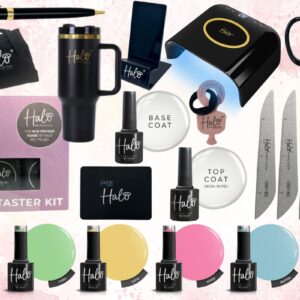
6 ways to attract & retain a diverse nail salon clientele
By Guest Writer | 03 March 2024 | Expert Advice, Feature

Nail artists, Carys Munro and Elsie Tate from South Wales, share top tips for attracting and retaining a diverse range of nail clients…
No one should feel out of place or like an inconvenience when they walk through the salon door. It is important to create a welcoming space for a diverse clientele and this involves proactive steps, such as targeted advertising and thoughtful consideration of accessibility factors. This includes addressing variables like the type of client chair, bathroom accessibility, room setup and lighting.
Offering a variety of nude nail shade options for different skin tones and implementing inclusive policies further contributes to a comfortable atmosphere. Advertising efforts should highlight inclusivity, showcasing diverse work on various hands to ensure representation for all clients, including those with unique features like disfigured fingers or clubbed thumbs. While it seems almost obvious to say, it means people will see these posts and think “Hey that looks like me, I can still get my nails done and the salon looks great!”
Recognising the individual needs of clients, especially considering factors like age, mobility issues and disabilities (including those which aren’t visible), is key to fostering an environment where everyone feels valued and comfortable. Here are our top tips:
1. Inclusive marketing
Using inclusive imagery and messaging in your marketing materials will help to show that your nail services are welcoming to clients of all backgrounds, skin tones and nail types.
2. Diverse service offerings
Offer a variety of nail services that cater to different styles, preferences and cultural influences. This could include a variety of nail art options, nail shapes and products suitable for different nail types. Consider diversifying from traditional ’salon’ treatments to include barbering and hairdressing, henna, piercings and tattoos, to increase the number of clients and expand your reach to those with a variety of preferences.
Keep The Faith salon in Cardiff, Wales, is presented as a ‘self care studio’. It provides a range of services including tattooing, nails and hair. The studio fosters inclusivity through the space and its employees, creating a welcoming space for clients irrespective of gender, sexuality, age, race or expression.
3. Cultural competency training
Implementing cultural competency training is a key step in fostering an inclusive and understanding workplace. This training should encompass comprehensive education for employees to not only recognise, but effectively cater to the distinct needs and preferences of clients from diverse cultural backgrounds.
It goes beyond surface-level awareness, delving into the intricacies of cultural nuances, communication styles and practices that may impact client interactions. By investing in such training, organisations equip their employees with the necessary skills to navigate cultural diversity sensitively and respectfully, creating an environment in which clients feel valued and well-served, regardless of their cultural affiliations.
4. Representation
Demonstrating the versatility and inclusivity of your salon is key to attracting a broad clientele. As well as diversifying nail designs and styles, incorporate a range of hands within your portfolio and social media content. By showcasing this variety, you communicate that your salon is adept at catering to clients with a spectrum of preferences and backgrounds.
This not only highlights your creativity and skill, but assures potential clients that they can find representation and resonance in the showcased designs. Featuring a range of nail types reinforces your commitment to providing an inclusive space where every client can find a style that resonates with their individual taste and identity.
5. Community engagement
Demonstrating your commitment to serving a diverse clientele involves actively participating in events, forming partnerships and engaging in collaborations with various communities. These efforts not only showcase your dedication, but also establish a meaningful connection with a broad range of clients and social media followers.
6. Client feedback and communication
Regularly ask clients for feedback in order to understand their needs and preferences, and utilise this information to customise services for a diverse clientele. Additionally, maintain open communication with specific client groups to guarantee their comfort, ensuring that efforts to enhance accessibility are both thoughtful and effective.
Follow Carys Munro and Elsie Tate.

Read the latest issue










